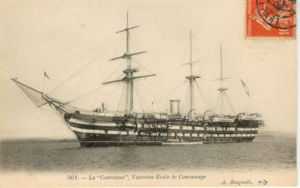French ironclad Gloire
 Gloire at anchor, 1860 | |
| Career (France) | |
|---|---|
| Name: | Gloire |
| Namesake: | Glory |
| Builder: | Arsenal de Toulon |
| Cost: | 4,797,901 francs |
| Laid down: | 4 March 1858 |
| Launched: | 24 November 1859 |
| Completed: | August 1860 |
| Struck: | 1879 |
| Fate: | Scrapped, 1879 |
| General characteristics | |
| Class & type: | Gloire-class ironclad |
| Displacement: | 5,618 tonnes (5,529 long tons) |
| Length: | 78.22 m (256 ft 8 in) |
| Beam: | 17 m (55 ft 9 in) |
| Draught: | 8.48 m (27 ft 10 in) |
| Depth of hold: | 10.67 m (35 ft 0 in) |
| Installed power: |
2,500 ihp (1,900 kW) 8 oval boilers |
| Propulsion: |
1 × Shaft 1 × Horizontal return connecting rod-steam engine |
| Sail plan: | Barquentine rigged |
| Speed: | 13 knots (24 km/h; 15 mph) |
| Range: | 4,000 km (2,500 mi) at 8 knots (15 km/h; 9.2 mph) |
| Complement: | 570 officers and enlisted men |
| Armament: |
|
| Armour: |
Hull: 120 mm (4.7 in) Conning tower: 100 mm (3.9 in) |
The French ironclad Gloire ("Glory") was the first ocean-going ironclad, launched in 1859. She was developed following the Crimean War, in response to new developments in naval gun technology, especially the Paixhans guns and rifled guns, which used explosive shells with increased destructive power against wooden ships, and followed the development of the ironclad floating batteries built by the British and French for the bombardment of Russian forts during the Crimean War.
Design and description
She was designed by the French naval architect Henri Dupuy de Lôme as a 5,630-ton broadside ironclad with a wooden hull. Her 12 cm-thick (4.7 in) armour plates, backed with 43 cm (17 in) of timber, resisted the experimental firing of the strongest guns of the time (the French 50-pounder and the British 68-pounder) at full charge, at a distance of 20 metres (65 ft).
Her official top speed was 13.1 knots but other reports suggested no more than 11.75 knots had been reached and that 11 knots was the practical maximum.[1]
As was common for the era, Gloire was constructed with sails as well as a steam-powered screw. The original rigging was a light barquentine rig providing 1,096 sq. m (11,800 sq. ft) of surface area. This was later increased to a full rig providing 2,508 sq. m (27,000 sq. ft) of surface.[2]
Service
Gloire was launched at the arsenal of Mourillon, Toulon, on 24 November 1859; and entered service in August 1860.
She was struck from the French fleet registry in 1879, and scrapped in 1883.
Importance in naval history
As the first ocean-going ironclad, Gloire rendered obsolete traditional unarmoured wooden ships-of-the-line, and all major navies had no choice but to build ironclads of their own. However Gloire was soon herself rendered obsolete by the launching in 1860 of the British HMS Warrior, the world's first iron-hulled ironclad warship.
Gallery
-

Photograph of Gloire, circa 1860, at the Musée de la Marine, Paris
-

The launch of Gloire
-

Gloire under sail, 19th century print
-

Scale model of Gloire at the Musée de la Marine
-

Couronne, near sister-ship of Gloire after she was rebuilt
Notes
Bibliography
- de Balincourt, Captain; Vincent-Bréchignac, Captain (1974). "The French Navy of Yesterday: Ironclad Frigates, Part I". F.P.D.S. Newsletter (Akron, OH: F.P.D.S.) II (2): 12–15, 18.
- Chesneau, Roger & Kolesnik, Eugene M., eds. (1979). Conway's All the World's Fighting Ships 1860–1905. Greenwich, UK: Conway Maritime Press. ISBN 0-8317-0302-4.
- Gardiner, Robert, ed. (1992). Steam, Steel and Shellfire: The Steam Warship 1815–1905. Conway's History of the Ship. London: Conway Maritime Press. ISBN 1-55750-774-0.
- Gille, Eric (1999). Cent ans de cuirassés français. Nantes: Marines. ISBN 2-909-675-50-5.
- Jones, Colin (1996). "Entente Cordiale, 1865". In McLean, David and Preston, Antony. Warship 1996. London: Conway Maritime Press. ISBN 0-85177-685-X.
- Roche, Jean-Michel (2005). Dictionnaire des bâtiments de la flotte de guerre française de Colbert à nos jours, 1671 – 1870. Group Retozel-Maury Millau. ISBN 978-2-9525917-0-6. OCLC 165892922.
- Silverstone, Paul H. (1984). Directory of the World's Capital Ships. New York: Hippocrene Books. ISBN 0-88254-979-0.
External links
| Wikimedia Commons has media related to Gloire. |
| |||||||||||
| |||||||||||||||||||||||||
